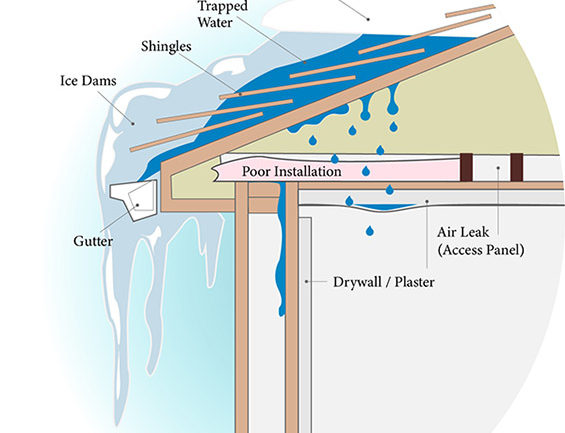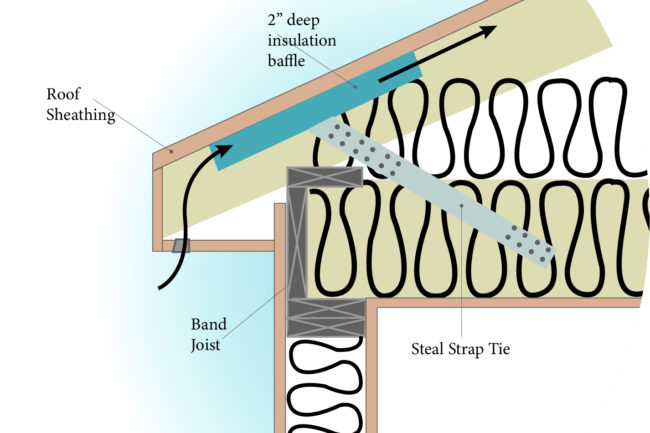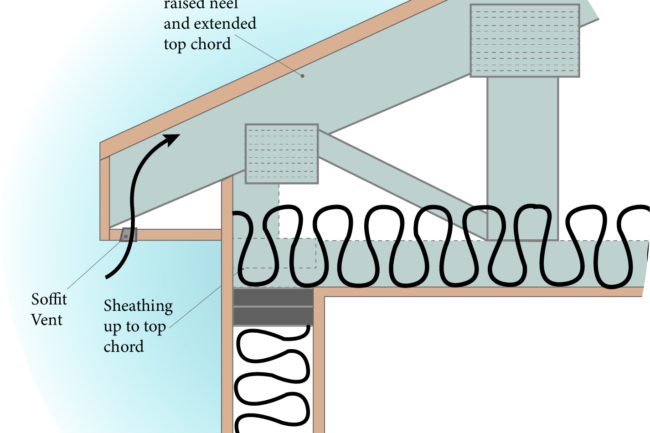The 411 on Ice Dams
While the St. Paul Winter Carnival is an ice lovers dream, the ice dams at your own castle can be a nightmare. So what are ice dams and how do we prevent them?
What Are Ice Dams?
Simply put ice dams are a result of the heat escaping from your roof, causing the existing snow and ice on your roof to melt. When your attic is not properly insulated, the heat escapes out of your attic floor through cracks and gaps. The water then pools into your gutter system, and as temperatures drop down the water refreezes.

If you look at the image above you can see the roof on this 1.5 story home. There are a couple things that you will notice when you looking at the house compared to the neighboring home. Many finished attics have inadequate insulation that allows heat to escape and melt the snow.
You can actually see the roof rafter lines because the wood conducts heat and may have some insulation between. Under the knee walls where it isn’t heated in the crawl space there is no heat to escape and the snow doesn’t melt. The water from above melts and runs down until it freezes near the edge.
How Do I Prevent Ice Dams?
A common misconception is that your gutters are not working properly. Many homeowners see the blockage and will replace the gutter system. While that may work as a quick fix, it is best to get to the root of the problem to prevent further damage.
Another method many homeowners try is roof rake the snow and ice off. This can actually damage the shingles. The melting and thawing repeatedly is what causes the big ice dams and build up of ice. This results in water backing up behind it then comes under the shingles and into the house.
The hard part is that once the space is finished it’s really hard to retrofit and insulate properly without tearing apart a finished attic at great expense. The easiest solution is to stop warm air from the house from leaking into your attic. Any existing cracks, gaps or holes within the walls and floors will need to be sealed. This will not only prevent further dams but it also will help your electricity bill by keeping the warm air in your home (and not your attic). Here at Castle Building & Remodeling, we have finished a lot of those attics and done closed cell spray foam insulation to help correct those water issues.
If your budget doesn’t presently allow you to re-insulate your home, you could also consider using Heattape. Heattape is a cable that will heat the ice enough to melt it but not cause damage to your home. It is another temporary fix but will suffice until you can go for more permanent solution. There are also companies you can hire that use steam to melt the ice from your roof. Make sure to hire an experienced company and do your research. We have heard good things from our customers about The Ice Dam Company.
Additional Things to Consider
While adding more insulation can be the next big part of the solution, another preventative measure to consider is the ventilation in your attic. It is important to make sure you are not trapping moisture within the space.

The boards that run horizontally under the roof edge are known as soffits. If you have insulation on the floor of your attic, within the soffit should be soffit vents, and in the attic there should be air chutes (sometimes called baffles). These chutes allow the cold air to flow between the attic space and soffit to exterior, therefore helping keep the eaves and roof cold and preventing heat/moisture from accumulating. Most newer homes are equipped with them, but many older homes are not.
If you create a “hot roof” though, where you spray foam the underside of the roof deck/between attic rafters, as is commonly done in story and a ½ attic finishes, you don’t typically use soffit vents or air chutes. The foam creates a barrier between heat in the finished attic space and the cold roof. If the roof can stay cold, you are less likely to get the ice dams. If there is enough room though, and the rafters can be furred down, it is possible to do a continuous vent from soffit to ridge, and use spray foam.

My home may have ice dams, now what?
If you suspect that your home may have ice dams, it may be time to give our team a call. Our experienced trade team can come out and assess the situation and provide you the best solution to your problem.
